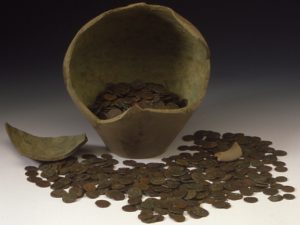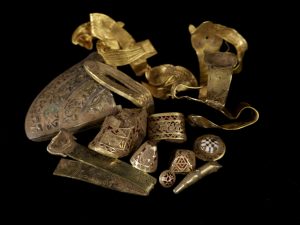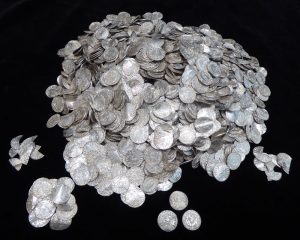PAS: Top 10 Finds
PAS: Top 10 Finds
In July 2020, the Portable Antiquities Scheme announced that it had recorded over 1.5 million items since it began 23 years earlier. To mark that milestone, the BBC History Magazine asked the PAS to “nominate 10 discoveries that they believe have done most to transform our knowledge of the past“
I have summarised that list below to demonstrate the enormous contribution that detectorist have made. You will see that of the 9 individual finds, 8 of them were found by metal detecting. All of these are now on public display or being studied at the British Museum. Without the work of detectorists, it is probable that none of these would ever have been seen.
Also, as demonstrated by the first item, if left in the ground, significant damage can be caused by plough action.
It is thanks to the open nature of the PAS database and in particular the facility to share its images, that enable these any other finds to be widely seen.
1. Ringlemere Cup
Detecting Find
Found by detectorist Cliff Bradshaw on 4 November 2001 near Sandwich, Kent.
Importance
Its demonstartes the metalworking expertise that existed in Bronze Age Britain. Its rounded bottom suggests a communal ritual use.
Public Display
It has been on a tour of several museums and is currently on display at the British Museum
3. Chalgrove Hoard
4. Staffordshire Moorlands Pan
Detecting Find
Found by a detectorist in Ilam in the Peak District in June 2003
Importance
A Roman enamel-decorated pan that was made as a souvenir of time served at Hadrian’s wall by a Roman named Draco.
On Display
It is on rotational display at Tullie House Museum, Potteries museum and the British Museum.
5. Staffordshire Hoard
Detecting Find
Found by detectorist Terry Herbert, a member of Bloxwich Research and Metal Detecting Club, on 5 July 2009, near Hammerwitch, Staffordshire.
Importance
It demonstrated the craftmanship of early Anglo-Saxon art and sparked public interest in that period of history.
On Display
The hoard has been on display at numerous museums including the British Museum and the Royal Armouries in Leeds.
6. Watlington Hoard
Detecting Find
Found by detectorist James Mather in 2015 in Watlington, Oxfordshire.
Importance
The coins found depicted Alfred the Great and Ceolwulf II together below and angel. This indicates a strategic and economic alliance between the two kings, which caused previous historical views to be rethought.
On Display
The hoard is on display at the Ashmolean Museum.
7, Chew Valley Hoard
Detecting Find
Found by a small group of detectorists in January 2019 in the Chew Valley, Somerset.
Importance
The 2,581 silver pennies found are a mixture of Harold II and William I, including some mules from both kings. They provide a valuable insight into the transition from Anglo-Saxon to Norman rule.
On Display
The coins are being examined by the British Museum and may be acquired for display at the Roman Baths in Bath.
8, Vale of York Hoard
Detecting Find
Found by David Whelan (from Leeds) on 6 January 2007 near Harrogate, North Yorkshire.
Importance
The contents of the hoard are from around the world. It demonstrates how widely the Vikings accumulated their wealth, either through trade or thieving.
On Display
As well as being on display at Yorkshire Museum in has been on tours of museums in this country and abroad, including Copenhagen and Berlin.
10, Bosworth Boar Badge
Detecting Find
Found during a metal-detecting survey of the site of the Battle of Bosworth.
Importance
Along with other evidence it moved the probable site of the Battle of Bosworth some 3km from where it had been previously thought to be.
On Display
On display at the Bosworth Battlefield Heritage Museum











